History and description
On the site of the present building, a construction for residential use had been erected, starting in the 15th century, consisting, according to medieval tradition, of two buildings side by side with underlying water cisterns and workshops. [1] The building stood at a crossroads, which in 1539 was to be transformed into a piazza by demolishing the surrounding hovels, at which time Cipriano Pallavicini, (elected in 1567 archbishop of Genoa) with his brothers Antoniotto and Gerolamo commissioned an author who has remained anonymous to design a new façade with a more modern façade and a design inspired by the Roman Palazzo Caprini by Donato Bramante. [2]
In 1571 the palace was sold to Antonio Brignole but in 1584 it returned to the ownership of the Pallavicino family in the person of Francesco Pallavicini, holder of the first inscription to the rolli dating back to 1599, the building also remained in the following rollo of the year 1614.
In the following centuries, ownership passed to the Grillo (family) (1713), to the Saporiti family (1718) and finally in 1840 to Federico Rayper from Ticino, supplier to the Navy of the Kingdom of Sardinia and father of the painter Ernesto Rayper, who asked permission to raise the building by two storeys and carry out an invasive general renovation during which almost the entire shell was emptied, the result being a building divided into flats, with decoration in the neoclassical [2] fashion.
All that remains of the Carlone family's great portal, preserved for more than a century at the Victoria and Albert Museum in London [3] and the Rubensian engravings.
Veduta della piazza di Fossatello, etching by Antonio Giolfi, 1796
Palazzo Caprini in the engraving by Antoine Lafréry

Genoa: Le Strade Nuove and the system of the Palazzi dei Rolli is a UNESCO World Heritage Site which includes a number of streets and palaces in the center of Genoa, in Northwestern Italy.

The Palazzo Doria or Palazzo Andrea e Gio. Batta Spinola is a palace located in Via Garibaldi, in the historical center of Genoa, in Northwestern Italy. It was one of the 163 Palazzi dei Rolli of Genoa, the selected private residences where the notable guests of the Republic of Genoa were hosted during State visits. On 13 luglio del 2006 it was included in the list of 42 palaces which now form the UNESCO World Heritage Site Genoa: Le Strade Nuove and the system of the Palazzi dei Rolli.

The Palazzo Spinola di Pellicceria, also known as Palazzo Francesco Grimaldi, is a palace located in piazza di Pellicceria in the historical center of Genoa, Northwestern Italy. The palace was one of the 163 Palazzi dei Rolli of Genoa, the selected private residences where the notable guests of the Republic of Genoa were hosted during State visits. On 13 luglio del 2006 it was added to the list of 42 palaces which now form the UNESCO World Heritage Site Genoa: Le Strade Nuove and the system of the Palazzi dei Rolli. It is currently owned by the Ministry of Cultural Heritage and Activities and Tourism and houses the National Gallery of Art in Palazzo Spinola.
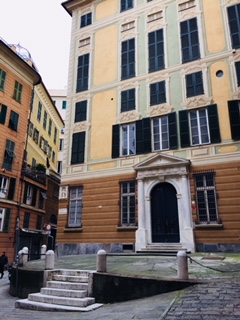
The Palazzo Clemente della Rovere is a palace located in Piazza Rovere in the historical center of Genoa, Northwestern Italy. The palace was one of the 163 Palazzi dei Rolli of Genoa, the selected private residences where the notable guests of the Republic of Genoa were hosted during State visits. On 13 luglio 2006 it was added to the list of 42 palaces which now form the UNESCO World Heritage Site Genoa: Le Strade Nuove and the system of the Palazzi dei Rolli. The palace hosts today the General Consulate of Iceland.

The palazzo Paolo Battista e Niccolò Interiano or palazzo Interiano Pallavicino is a building located in Piazza delle Fontane Marose at number 2 in Genoa, included on 13 July 2006 in the list of the 42 palaces inscribed in the Rolli di Genova that have become World Heritage by UNESCO.
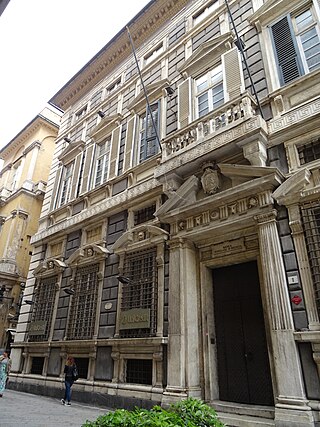
The palazzo Pallavicini-Cambiaso or palazzo Agostino Pallavicini is a building located in via Garibaldi at number 1 in the historical centre of Genoa, included on 13 July 2006 in the list of the 42 palaces inscribed in the Rolli di Genova that became World Heritage by UNESCO on that date.

The palazzo Pantaleo Spinola or palazzo Gambaro is a building located in via Garibaldi (Genoa) at number 2 in the historical centre of Genoa, included on 13 July 2006 in the list of the 42 palaces inscribed in the Rolli di Genova that became World Heritage by UNESCO on that date. The building is now the headquarters of the Banco di Chiavari e della Riviera Ligure.

The Palazzo Lercari-Parodi or Palazzo Franco Lercari is a building located at number 3, Via Garibaldi in the historical centre of Genoa, included on 13 July 2006 in the list of the 42 palaces inscribed in the Rolli di Genova that became World Heritage by UNESCO on that date.
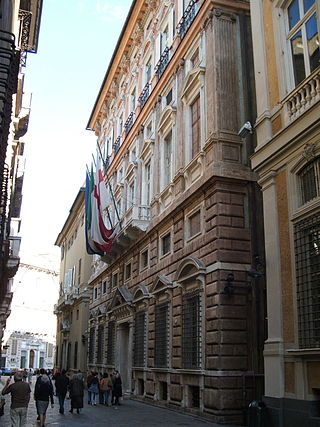
The Palazzo Carrega-Cataldi or Palazzo Tobia Pallavicino is a building located in via Garibaldi (Genoa) at number 4 in the historic centre of Genoa, included on 13 July 2006 in the list of the 42 palaces inscribed in the Rolli di Genova that became World Heritage by UNESCO on that date. The building is now the headquarters of Genoa's Chamber of Commerce.
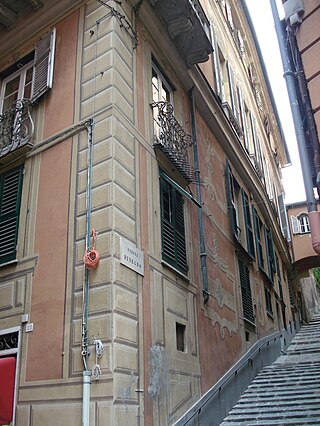
The palazzo Giorgio Spinola is a building located in Salita Santa Caterina|salita di Santa Caterina at no. 4 in Genoa, included on 13 July 2006 in the list of the 42 palaces inscribed in the Rolli di Genova that became World Heritage by UNESCO on that date.

The palazzo Giacomo Spinola or palazzo Giacomo Spinola di Luccoli is a building located in Piazza delle Fontane Marose at number 6 in Genoa, included on 13 July 2006 in the list of the 42 palaces inscribed in the Rolli di Genova that became World Heritage by UNESCO on that date. The palace is now home to the Banco di Sardegna.
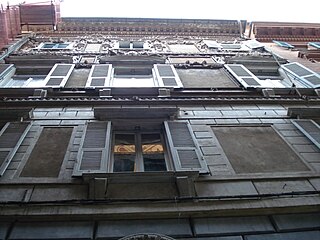
The Palazzo Tommaso Spinola, also known as Palazzo Tomaso Spinola di Luccoli or Palazzo Spinola Pessagno, is a building located in salita di Santa Caterina at number 3 in Genoa, included on 13 July 2006 in the list of the 42 palaces inscribed in the Rolli di Genova that became World Heritage by UNESCO on that date.

The Palazzo Lomellini-Doria Lamb', also called Palazzo Stefano Lomellini, is a building located in Via Cairoli (Genoa) at number 18 in the historical centre of Genoa, included on 13 July 2006 in the list of the 42 palaces inscribed in the Rolli di Genova, which on that date became World Heritage by UNESCO.

The Palazzo Cosma Centurione is a building located in the historical centre of Genoa, in Via Lomellini at no. 8, included on 13 July 2006 in the list of the 42 palaces inscribed in the Rolli di Genova that became World Heritage by UNESCO on that date. Also known as the Palazzo Durazzo Pallavicini or Palazzo di Gerolamo III Pallavicino, from the name of its successive owners, due to its architecture and the frescoes preserved inside, it is an outstanding example of Genoese Baroque.

The Palazzo Giorgio Centurione is a building located in Via Lomellini at no. 5 in the historical centre of Genoa, included on 13 July 2006 in the list of the 42 palaces inscribed in the Rolli di Genova that became World Heritage by UNESCO on that date.

The Palazzo Gio Battista Grimaldi is a building located in Piazza San Luca at number 2 in the historical centre of Genoa, included on 13 July 2006 in the list of the 42 palaces inscribed in the Rolli di Genova that became World Heritage by UNESCO on that date. The Church of San Luca (Genoa) is located in the same square.

The Palazzo Giacomo Lomellini, also known as the Palazzo Patrone, is a building located in Largo Zecca at number 2 in Genoa, included on 13 July 2006 in the list of the 42 palaces inscribed in the Rolli di Genova that became World Heritage by UNESCO on that date.

The palazzo Bernardo e Giuseppe De Franchi Toso is a building located in Piazza della Posta Vecchia at number 2 in historic centre of Genoa. The building was included in the list of palaces inscribed in the Rolli di Genova. It was an important seat of the Italian Socialist Party from 1952 to 2003.
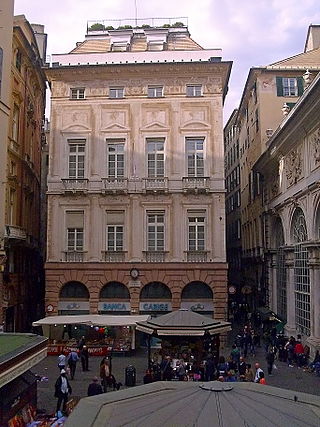
The Palazzo Ambrogio Di Negro is a building located in Via San Luca at number 2 in the area of the Mercato di Banchi in the historic centre of Genoa, included on 13 July 2006 in the list of the 42 palaces enrolled in the Rolli di Genova that became World Heritage by UNESCO on that date. It preserves an important Mannerist painting cycle inside. In front of the palace is the Loggia dei Mercanti (Genoa) and the Church of San Pietro in Banchi.

Giovanni Ponzello was an Italian mannerist architect active in the Republic of Genoa, where he supervised the construction of several distinguished palaces and churches during the Renaissance period.
























